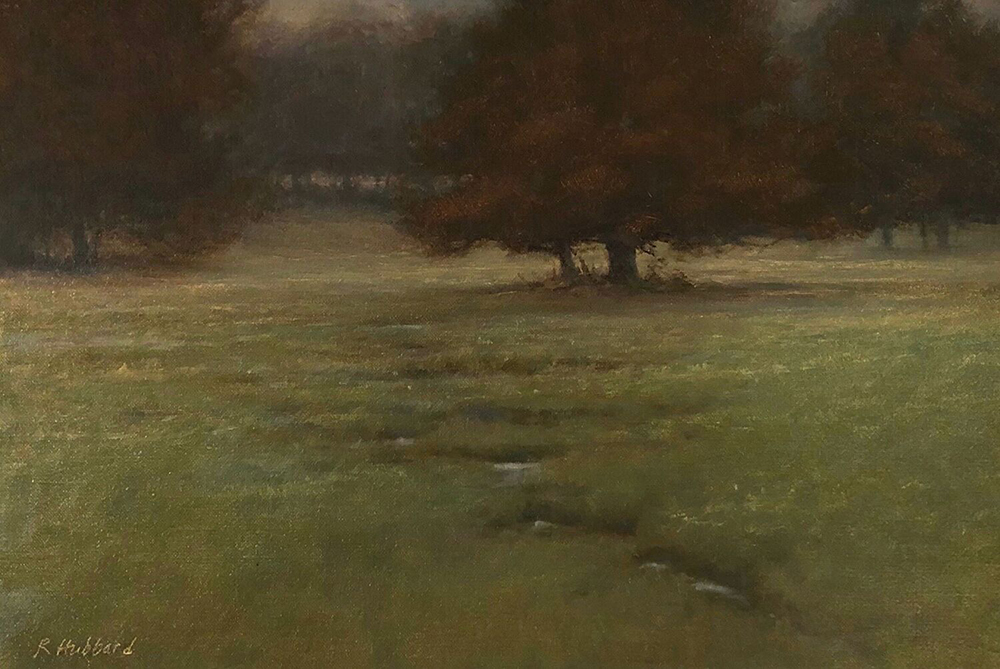
“Minor Key Tonality” by Rozanne Hubbard. The 10 x 15 inches oil on linen panel painting depicts a landscape she’s studied somewhere between Tremont and Delavan. (SUBMITTED PHOTO)
Rozanne Hubbard has been painting landscapes for fifty years. Preserving a moment in time, Hubbard explores the human relationship to nature, capturing the essence of the land intertwined with environmental awareness.
“Minor Key Tonality” is a painting referencing a rural setting that Hubbard often drives past on the way from Tremont to Delavan. Mesmerized by the area’s beauty, Hubbard would often stop to take photos of the marshy fields, eventually asking the property owners if they minded her sketching on site. With an open invitation, the artist became familiar with the area.
Many have referred to Hubbard’s paintings as melancholy, and she believes there is some truth to this observation. Closely examining the landscape since her early twenties, the artist has noted many transformations of the places she has painted.
The Midwest landscape is often vulnerable to ecological disturbances — agriculture, deforestation, landfills, expansion of transportation systems, and housing developments.
Hubbard’s paintings are somber, revealing undertones of loss and longing while paying homage to the land. Possibly the scenery within Hubbard’s paintings are aware of its fragile existence?
In line with the Tonalist art movement, Hubbard’s paintings evoke a spirit of promise and contemplation. Using soft brushwork of closely related, muted hues, the artist creates a harmonist world within reach.
Hubbard, initially trained as a graphic designer, but switched exclusively to fine art early in her career. The artist informed her practice by reading about other painters and their techniques, visiting galleries and museums, and attending numerous workshops. Two notable workshops instrumental to Hubbard’s artwork were with artist Lynne Windsor in Scotland and Dennis Sheehan in New Hampshire.
Methodical in her process, Hubbard paints with thin veils of transparent layers using a wipe-out and glazing technique.
“I like to use a tonal underpainting,” she said. “I use one tonal transparent color overall, typically a dark value, then remove it with paper towels, brushes, or Q-tips for the lighter value. After it dries, I go back in to add opaque color; then, after that layer dries, I might put a transparent glaze over some areas that need toning down. Sometimes the first transparent layer is enough, and the painting is done. I like it when that happens.”
Hubbard’s art diverts from the actual representation of the landscape she is painting.
“A lot of the landscape I am painting you would not be able to recognize from the reference materials,” said Hubbard, who makes adjustments based on compositional needs and her emotional connection to the environment. “They morph to a different painting, the paintings dictate to me what direction it is going to go.
“I just try to follow along because they change a lot.”
Hubbard often takes trips to Door County, Wis., where she has her artwork at Edgewood Orchard Galleries. During these visits, the artist spends a lot of time exploring the Peninsula State Park, Cave Point, Newport State Park, and Whitefish Bay. “The whole county is a peninsula,” she said. “So there are a lot of shorelines, bluffs, forests, wetlands, and orchards. There are a lot of people there who are passionate about preserving the land in Door County.”
The artist, who is in tune with the benefits of spending time outdoors, reflects that “humans are a part of nature, but we are so removed from it today.”
Hubbard’s paintings are not only beautiful to view, but they remind us of the importance of preserving the land so others may admire it in the future. Documenting the present in the hope that it will remain, the artist encourages us to enjoy and take care.
Rozanne Hubbard’s artwork may be found at https://www.rosehubbard.com/ and https://edgewoodorchard.com/


1 comment for “Inland Art | Passion for preservation lies beneath local landscapes”
Recent Comments
I so enjoyed reading this article about such a fine artist using her talent to speak for the natural world. Her art is soulful and much needed in the present day and uncertain times. We all need to see ourselves as part of nature as Roxanne does.